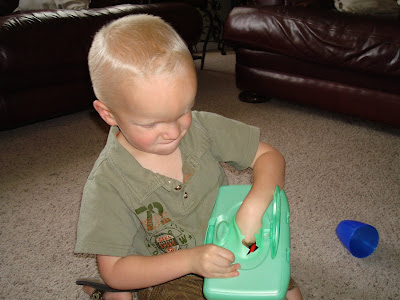This was a fun , easy, and inexpensive project. And my kids loved it!
Balloon Balls
Materials Needed:
(to make 4 balls)
- 1 lb. lentils
- 12 12" balloons
- funnel
- scissors
Here's How:
Take one balloon and blow it up.
Don't tie the end off, but hold it closed for 30 seconds or so to stretch it out.
Deflate the balloon and stretch the opening over the funnel.
Pour 1/2 - 3/4 c. of lentils into the funnel, pushing them down into the balloon as you go.
Once the balloon is full, take another balloon and cut off the neck
(Cannon's favorite part was cutting!)
Now cut the thicker round end off of the balloon that you filled with lentils.
Stretch the neck around the balloon to keep them from falling out.
Now take the balloon that you cut the entire neck off of (the pink one),
and stretch it around the lentil filled balloon (to keep the neck closed and in place).
Now take a third balloon and cut the neck off of it completely.
(This picture shows the orange end cut off, and now the orange balloon is tucked inside of the pink one. The white balloon also has the neck cut off so it can go around the pink one.)
Now take the white balloon and stretch it around the pink layer (making the 3rd and final layer).
Be sure and cover the opening of the pink balloon completely to seal it off.
And you're done!
Now make 3 more with your remaining lentils and balloons.
These balls feel really cool!
They have a very squishy, soft texture, and my boys LOVED it!
Perfect for throwing, squishing and rolling.
They are just the right size for little hands.
AND... they have successfully survived Lincoln!
Who has chewed, slobbered and tried to mangle them on a daily basis!
Totally kid proof!
Have fun!

























